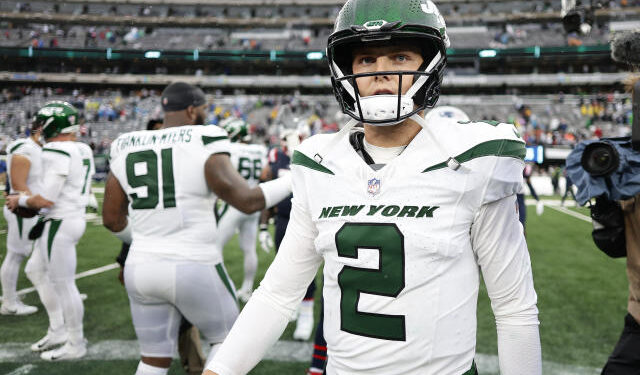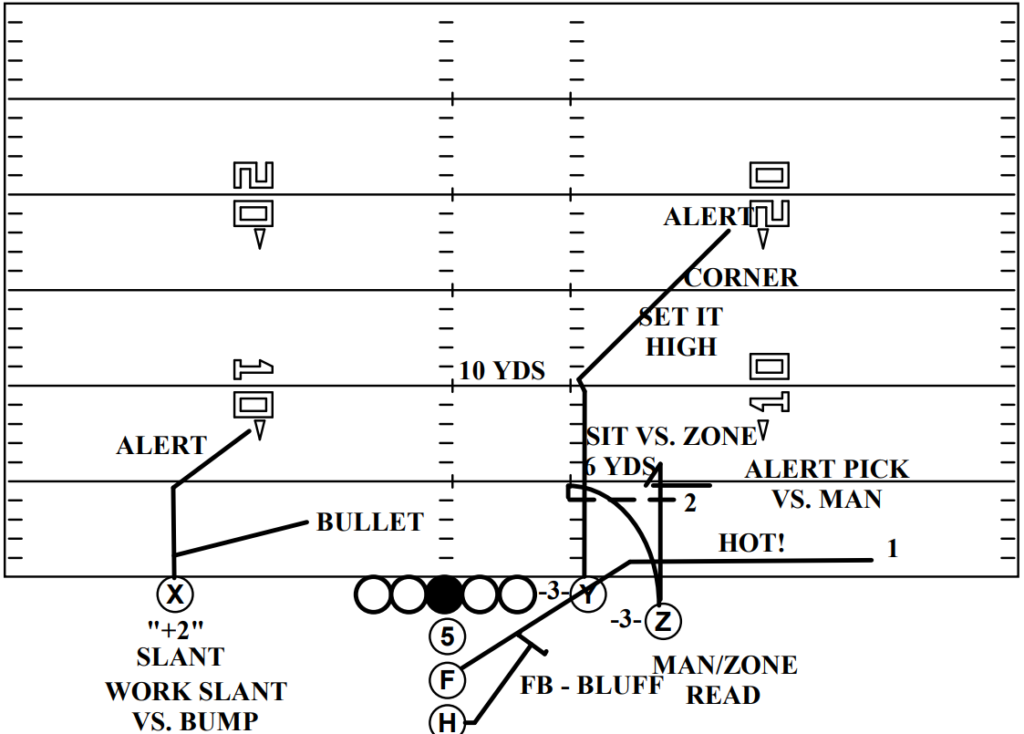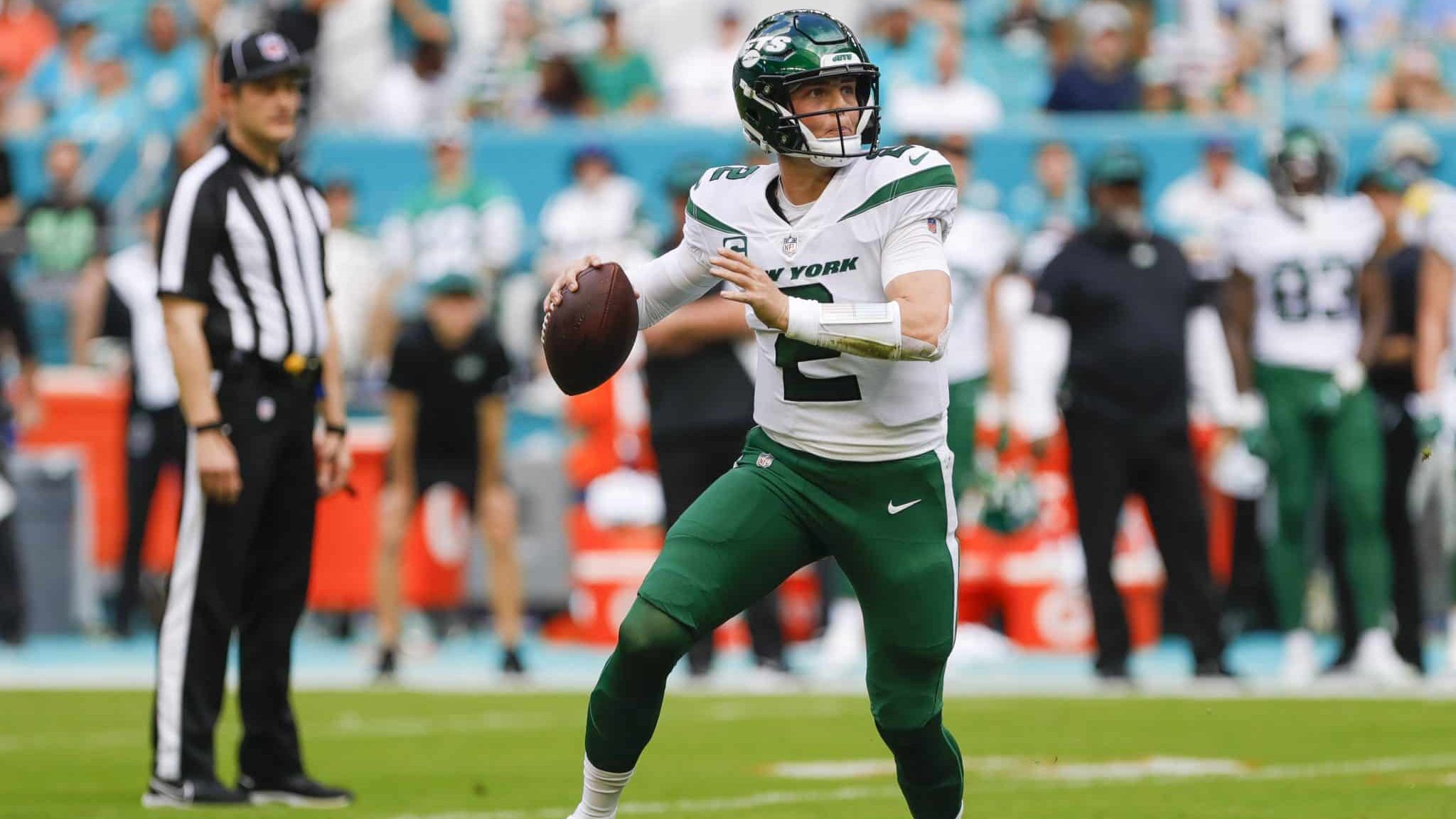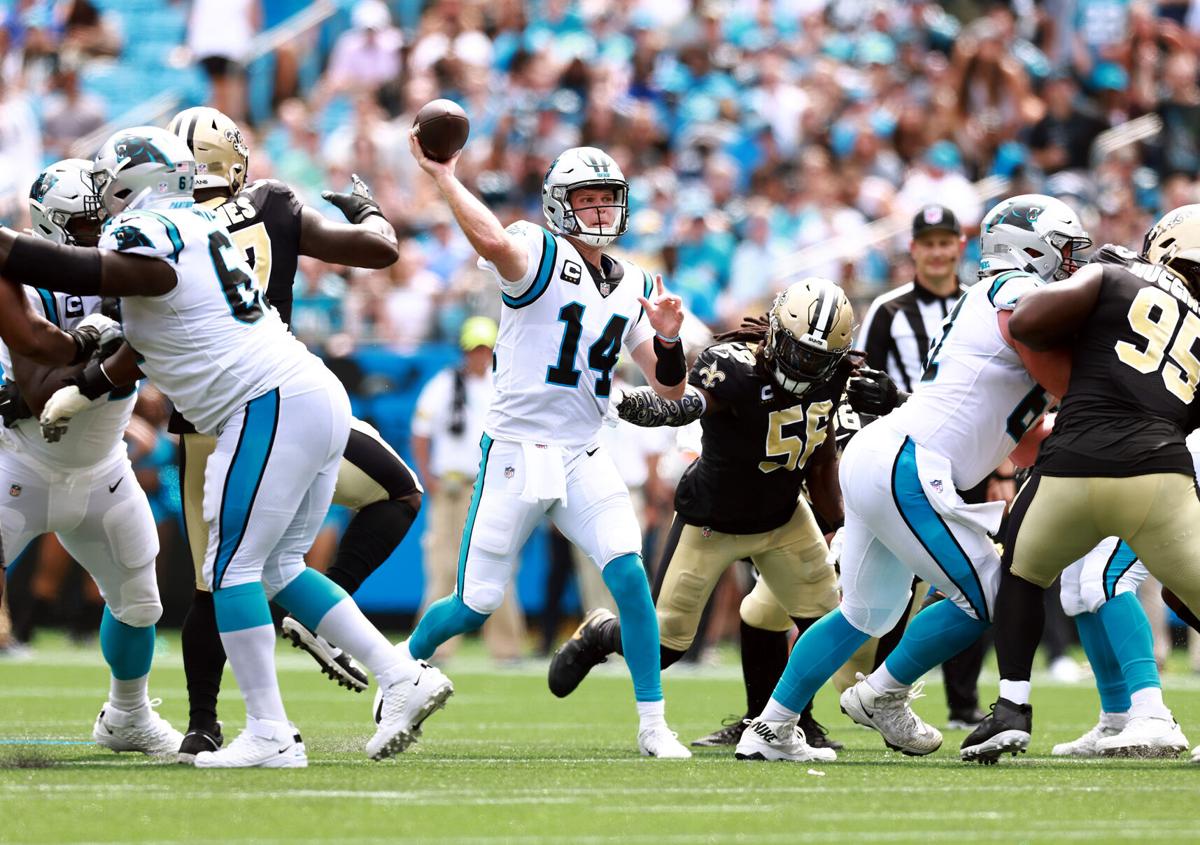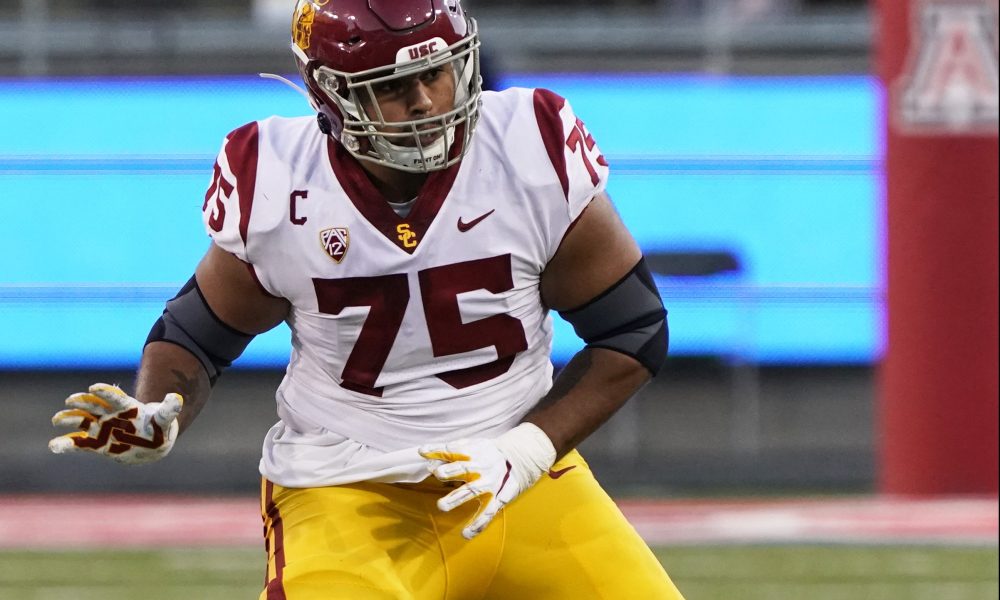By Bill Carroll
When I was scouting Zach Wilson in his days as the quarterback at BYU, I saw all of the talent and traits that led to Zachary Kapono Wilson being selected, second overall, by the Jets in the 2021 NFL Draft. His arm-strength, mobility and competitive drive were on display throughout his BYU career. He had an exceptional college career, he posted a 96.5 Clean Pocket Grade from PFF, the highest rating in the nation, setting a new PFF record. They scored him with an overall passing grade of 95.5, topping Joe Burrow’s 2019 score of 94.9.
Despite all of that, as with fellow New Jersey/New York quarterback, Daniel Jones, I had serious concerns and I had assigned both third round grades as talented, development quarterback prospects. Zach Wilson reminded me of a few quarterbacks that I had evaluated in the past, from Stefan LeFors to Cade Brem McNown. However the prospect that I most saw, while scouting Zach Wilson, was Jay Christopher Cutler.
Zach Wilson’s strengths included: accuracy while on the go, creativity, deep ball touch, physical toughness and use of varied release points. I felt that his biggest weaknesses were, accuracy in seeing late safety rotation, being able to anticipate open targets and decision-making, especially versus disguised coverage, [see the game against against Coastal Carolina], mechanically he needed to be more careful with ball-carriage in the pocket and some over-striding would make him throw the ball too high.
Once he began working with coach Mike LaFleur, the then offensive coordinator and play-caller for the New York Jets, nearly all of Zach Wilson’s weaknesses and some of his strengths came to the fore. Structurally that passing game resembled what the 49ers and Rams both do.
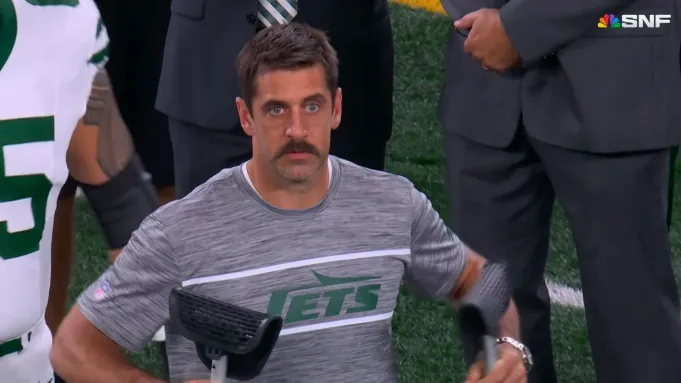
Unless you have spent the last several months on a “Darkness Retreat” you are already aware that offensive coordinator, Nathaniel Hackett and the scheme were selected not for Zach Wilson to be the conductor of the “Hackett Offensive Orchestra”. That ‘baton’ was to have been in the steady hand of Aaron Charles Rodgers. His Achilles tendon tear is what put Zach Wilson and offensive coordinator, Nathaniel Hackett in a white-hot spotlight.
The 10 Zach Commandments can shape Coach Hackett’s approach to designing and calling plays within his system:
10 Zach Commandments: Scheme
- Quick Passing Game: The West Coast Offense emphasizes getting the ball out of the quarterback’s hand quickly. Coach Hackett’s play design often involves short, horizontal passes allowing receivers to gain yards after the catch. Quick throws help negate pass rush and keep the offense in favorable down-and-distance situations.
- Timing and Rhythm: Timing is crucial in all versions of West Coast Offense. Hackett emphasizes precise route-running and quarterback-receiver chemistry. Plays are designed based on a specific number of steps or seconds in the quarterback’s drop-back, optimally the ball is released on time, often before the receiver make their route break. Holding the ball is “Kryptonite” in this offense.
- Variety of Formations and Personnel Groupings: To keep defenses guessing, Hackett uses a variety of formations and personnel, including shifts, motions, and different alignments to create confusion and hesitation for defenders. He has employed multiple tight end sets, three-receiver formations, even versatile ‘space’ players in various roles adapting to situations.
- Route Combinations: Hackett’s play designs feature complex route combinations. Receivers run precise option routes, based on the coverage they read. This version of West Coast Offense often incorporates high-low reads, where a short and deep route are paired together, forcing defenders to choose and create opportunities for the offense. Both Smash and Snag Route variants are common. Smash and Snag routes are common passing concepts used in football, in West Coast Offense and other systems. The routes are designed to create opportunities for receivers to exploit certain areas of the field, especially with short to intermediate passes. Below, I’ll describe and provide diagrams of the Smash and Snag routes: 1. Smash Route:The Smash route concept is designed to attack the soft spots in zone coverage or exploit mismatches in man-to-man coverage, particularly near the sidelines. It typically involves two primary routes:
- Corner Route (or “Smash” Route): One receiver runs a corner route, which is a diagonal route toward the sideline and the back corner of the end zone. This route stretches the deep coverage defenders and can be a scoring opportunity.
- Hitch or Quick Out Route: Another receiver, often a slot receiver or a tight end, runs a shorter route such as a hitch (a quick stop and turn towards the quarterback) or a quick out (a route that breaks toward the sideline at about 5-7 yards from the line of scrimmage). This route is the “Smash” component of the concept, designed to sit in front of the coverage and give the quarterback a safe, short option.
Diagram of Smash Route Concept:
The idea behind the Smash concept is to read the defense. If the corner-back sinks with the deep corner route, the quarterback throws the hitch or quick out. If the corner-back jumps the short route, the quarterback throws to the deep corner route.
2. Snag Route:
The Snag route concept is designed to attack zone defenses and create quick, easy throws for the quarterback. It involves three primary routes:
- Flat Route (or “Snag” Route): One receiver, often the outside receiver, runs a quick route to the flat, a few yards past the line of scrimmage, providing an easy check-down option for the quarterback against a defense taking deep drops.
- Slant Route: A slot receiver runs a slant route, angling towards the middle of the field at about 5-7 yards depth. This route occupies the attention of the linebackers and creates a window for the next route.
- Curl or Quick In Route: Another receiver, often a tight end or a slot receiver, runs a route where they break back towards the quarterback at about 10-12 yards from the line of scrimmage. This route sits down in the soft spot of the zone, creating a reliable intermediate target.
Diagram of Snag Route Concept:
The Snag concept creates a progression for the quarterback, the outside flat route serves as a quick check-down, the slant occupies the intermediate defenders, and the curl or quick in routes provide a mid-range option. [Note: the slant can be converted to a slant and go and the curl or quick in route can convert to a “Dig” or deep in route, if the match-ups are favorable.]
These route concepts are effective in many situations, in part, because they are adjusted based on coverage. Quarterbacks and receivers must be on the same page while reading defenses to make correct decisions based on reading coverage. As an example, both horizontal and vertical routes can change as the receivers run through versus man coverage, but are to settle and show their numbers to the quarterback, versus zone coverage.
- Running Game Integration: While the West Coast Offense is predominantly a passing-oriented system, Coach Hackett’s offense shows the importance of balance. He incorporates a diverse running game that includes inside and outside zone runs, draws, and screens, which are a short passing extension of running concepts. The intent is to keep the defense honest and set up play-action passes.
- Adaptability: Hackett’s approach should be adaptable to the strengths and weaknesses of the players. When during the 49ers dynasty run, they transitioned from Montana to Young, they tailored both play-design and play-calling to maximize the abilities of each quarterback and skill position players. Whether it’s a mobile quarterback who can run bootlegs or a reliable tight end with excellent route-running skills, Hackett adjusts his game plan accordingly.
- Situational Awareness: Coach Hackett’s offense demands situational awareness, particularly in critical moments of the game. To maximize the scheme the quarterback must understand when to be aggressive and take shots downfield, and when to play conservatively to protect a lead or manage the clock effectively.
- In-Game Adjustments: Adaptability and in-game adjustments are hallmarks of Hackett’s coaching style. If he identifies specific weaknesses or tendencies in the defense, he’ll make quick adjustments to exploit those weaknesses and create favorable match-ups.
- Taking What The Defense is Giving: This is one of the most challenging things for young quarterbacks. All of their developmental years they have likely been praised for aggressiveness and making tight-window throws. ‘Wow throws’ are like spectacular dunks, they are very exciting, but they score the same number of points as a routine play. Quarterback Zach Wilson must read the defense quickly and progress through reads efficiently. Start with high-percentage, short-yardage options and work rapidly through progressions, avoid getting ‘stuck’.
- Outside zone/TE drag RPO: A staple play in the 49ers’ offense. Often this is run out of 21 personnel because teams often go 4-3 vs them with a Cover-3 look. The defense brings the safety down in the box, usually strong, leaving the backside curl vulnerable. The 49ers love to run this on first down. Outside zone, QB reads the middle linebacker and the TE is dragging the other way, Marcus Cole Arroyo used this to great effect when he was running Oregon’s offense.
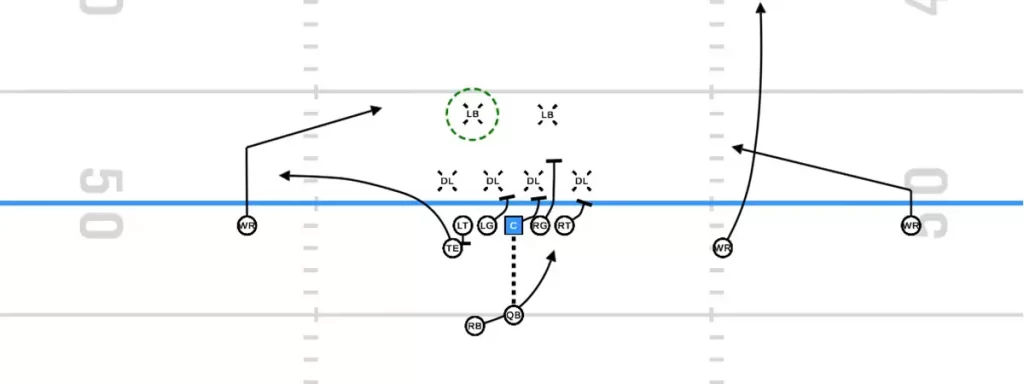
Via Fishduck.com
To understand the overarching philosophy, Nathaniel Hackett’s approach to designing and calling plays in the West Coast Offense revolves around quick, precise passing, timing, adaptability, and situational awareness. The scheme’s ability to create mismatches, utilize versatile personnel, and make in-game adjustments are paramount if he is to be an effective coordinator in this offensive system.
Coach Hackett is a coaching legacy. His father, Paul Hackett, was also known for his expertise in the West Coast Offense, and his approach to designing and calling plays within this system reflects the core principles of the scheme. The West Coast Offense is characterized by its short and precise passing game, quick timing, and the use of high-percentage throws to move the ball down the field.
If Zach Wilson were to “un-bust” he would join a rare fraternity who had poor early careers and become good or even great later. Sunday night Zach Wilson completed 28 of 39 passes for 245 yards and two touchdowns, with a career high QB rating of 105.2. For this very difficult feat to transpire Zach Wilson most follow the 10 Zach Commandments and save “hero ball” for very special occasions.


 NFL
NFL